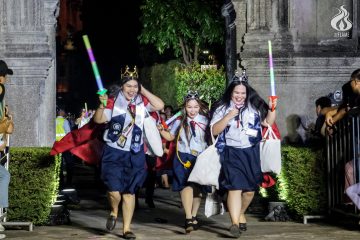WHAT HAPPENS if the greatest Filipino artists collaborate on a single work? How far can their artistic madness go?
One may find the answers in a Filipino rock opera ballet adaptation of the Indian epic “Ramayana,” which took five national artists to create before it premiered in 1980.

After its last restaging 11 years ago, the historic work was revived last September at the Metropolitan Theatre and Samsung Performing Arts Theatre, and is set for another run in February 2024. A filmed performance from the recent restaging will also be screened online by the Metropolitan Theatre on Saturday, Nov. 11, on its Facebook page.
Performed by the Alice Reyes Dance Philippines (ARDP), and with its creator Alice Reyes still at the helm, Rama, Hari was a frenzied, sumptuous and masterful feast of Filipino artistry, one that this generation is lucky enough to experience.
The rock opera chronicles the fraught journey of Rama, the incarnation of the Hindu god Vishnu, and his wife Sita. The theme of the show is presented right from the get-go: “Ito ay kasaysayan ng dakilang tunggalian ng kabutihan at kasamaan (This is the history of the glorious struggle between good and evil),” a quasi-Greek chorus intones, voiced from the pit by the Ryan Cayabyab Singers.
Everything is well for Rama: he weds Sita, the daughter of King Janaka of Mithila, as he waits to be crowned in the kingdom of his father Dasaratha (Audie Gemora and Lester Reguindin).
However, Rama’s stepmother Kaiyeki (Maron Mabana and Janine Arisola) schemes against Rama and manipulates Dasaratha to crown their son Bharatha instead. By the end of Act I, Rama is banished from his kingdom for 14 years, accompanied by Sita and his loyal brother Lakshmana (Jonathan Abella and Erl Sorilla). In Act II, their journey only becomes more convoluted, astir with demons, monkeys and battle scenes.
Clocking in at two hours, Rama, Hari is an astonishingly ambitious conception, but Reyes has always had a desire to break new ground. In 1977, she mounted “Tales of the Manuvu,” a rock opera ballet that tells the creation story of the Manobo in Mindanao. Eager to push the possibilities of dance and theatre further, she ventured into Asian sources in 1979 and was drawn to the “Ramayana,” an influential text that continues to be retold across Southeast Asia to this day.
“I just wanted to do something crazy,” she said in a press conference.

She worked in close collaboration with five pioneering artists of the time for Rama, Hari, two of whom were alumni of the UST Faculty of Philosophy and Letters, presently known as the Faculty of Arts and Letters (AB).
Bienvenido Lumbera, National Artist for Literature and AB Journalism alumnus—who previously worked with Reyes on “Tales of the Manuvu”—was again tapped to write the libretto. Rolando Tinio, National Artist for Theatre and Literature and AB Philosophy alumnus, wrote the English translation of the libretto. Ryan Cayabyab, National Artist for Music, wrote the music, while Salvador Bernal, National Artist for Theatre Design, designed the sets and costumes.
It is often said that the story is only as good as the way it is told. Indeed, in Rama, Hari, the outrageous ways that Reyes and her band of National Artists contrived to retell the classical Indian epic in a distinctly Filipino spirit was as substantial as the narrative itself.
Immediately eye-catching was Bernal’s set design, which had ornately painted portals hanging from the ceiling, redolent of Indian temples. However, the stage, an expansive white slope with stairs and platforms, was surprisingly stark for an opera. Yet it proved to be a versatile space for displaying a large ensemble at maximum advantage. As soon as the opulently dressed dancers leaped into the space, one believed that they were in a royal court in Mithila, the Panchavati forest or in a monkey kingdom called Kiskinda.
The libretto is a work of a chameleon—Lumbera’s diction shapeshifted with each character. His lines can be jagged and unabashedly contemporary: the monkey commander Hanuman calls Rama “manedyer;” the townspeople sing of a “happening” in Mithila; and the demon-king Ravana calls himself “kalog.” According to Lumbera, he wanted to jar audiences “into perceiving that the ancient epic of India is also now and ‘Filipino.’ ”
That the slang words Lumbera used are a tad dated now did not diminish their effect. In one scene, the demoness Soorpanakha attempts to seduce Rama and blares: “Type mo bang magtrip sa akin, / Wow na wow ang ‘yong appeal, / Ay, I cannot make pigil, / Type kitang kainin…” Viewers guffawed over them as though they were written yesterday.

However, Lumbera could also wield the Filipino language in its pristine and elevated form. For instance, Rama and Sita sing in a duet: “Magiging butil ang hamog, / Mananaog ang buwan sa bundok, / May punlang sisipot sa tudling na baog…” His sheer mastery of the native language gave way for its sweetness to steam and shine like a brook flowing down a mountain.
All of Lumbera’s words were set to Cayabyab’s music, which matched his shifting diction. Played live by the Orchestra of the Filipino Youth—with about 70 musicians ranging from teenagers to 25-year-olds—under the baton of Toma Cayabyab, the score sounded grand and sonically daring.
Cayabyab experimented with a diverse range of styles: from kundiman, Philippine indigenous music and classical Indian melodies to soul, jazz fusion and the then-bourgeoning pop genre called “Manila sound.” Such an eclectic mix of genres is a formula for a failed ambition if it were handled by a lesser composer. But Cayabyab, who was a 26-year-old delayed student from the UP College of Music when he wrote the score, created music so innovative that it still sounded fresh today. In song after song, notably “Tagistis ng Ulan,” “Iisa ang Tibok,” “Luwalhati sa Kagubatan” and “Magbalik Ka Na, Mahal,” the music made Lumbera’s words soar.
The music could hardly have been better sung or danced. On the opening night at the Metropolitan Theatre, Rama was sung to the hilt by the tenor Arman Ferrer (alternating with Vien King). Sita was sung by Shiela Valderrama-Martinez (alternating with Karylle Tatlonghari and Nica Tupas) with a clear voice that is at once strong and delicate. Memorable were Raflesia Bravo’s Soorpanakha and Matthew San Jose’s Ravana—both raunchy and brash, each bringing the house down with their villain numbers. Unfortunately, all of the actors were under-amplified, leaving viewers grasping for intelligible words amid the music.
The heart of the work is Reyes’s choreography. Here is where she pushed the boundaries of the theatrical form. She fused opera and ballet by having a dancer and a singer play the same role. The result was an eloquent dialogue between the emotive capabilities of voice and movement, with both mediums completing the characters.
There was a tensile kind of grace in Reyes’s choreography, which blends the classical and modern ballet idioms. In spite of its high level of technical difficulty, every dancer moved with lightness and precision. Ronelson Yadao, the company’s artistic director, danced the role of Rama and brought vulnerability to the hero’s character. Monica Gana embodied Sita’s grace and steadfast strain. Richardson Yadao as Ravana was particularly memorable: his role was marked with ostentatious big leaps, and he did not seem to care at all about them.

As in most operatic works, Rama, Hari provided viewers with a communal space to escape the tedium of daily life and enter an outlandish world where heroes travail and win. But after a three-year global pandemic, one also feels that this restaging is a proclamation of triumph.
Filipino artists struggled heavily during the pandemic. In fact, Reyes established the ARDP in the middle of 2020 to provide jobs for displaced dancers. The rock opera was also supposed to be staged in March 2020 by Ballet Philippines, Reyes’s former dance company, but was halted by the pandemic, just a week shy from premiering. Now that the artistic community in the country is getting back on its feet, this revival shows the great heights that Filipino talent is capable of reaching.
Ultimately, what has triumphed in Rama, Hari is sheer Filipino creativity. And as in all epics where the hero makes a homecoming, this masterpiece has finally made its victorious return for the new generation. F



